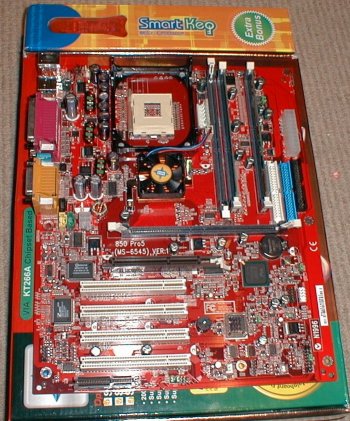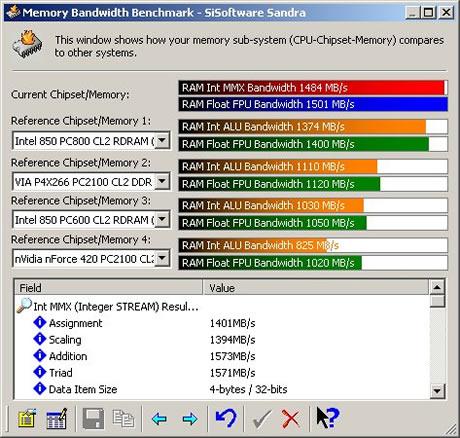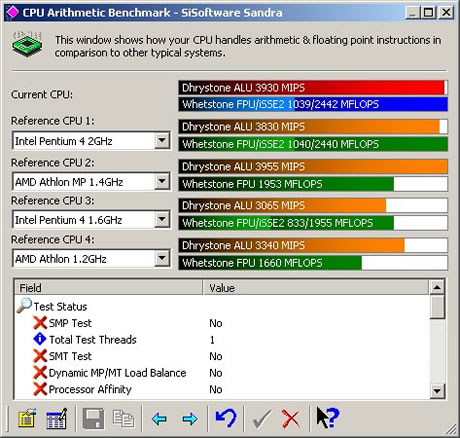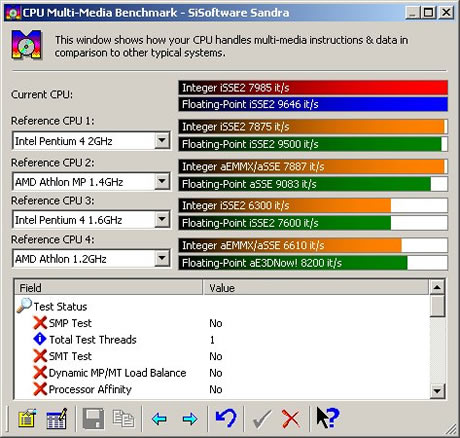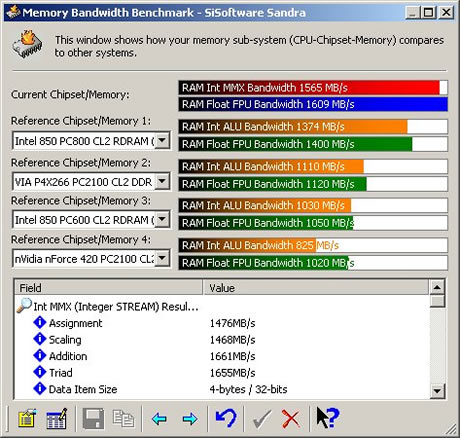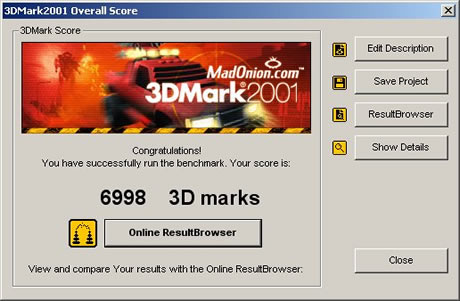MSI 850 Pro5 Motherboard
|
Introduction Intel's Pentium 4 processor has been around for over 12 months now and thus has had time to gain market acceptance, developer support and price cuts to make it a viable solution for users. Originally the cost of the processor and supporting subsystems such as the motherboard and memory were prohibitive and with AMD offering better performance for a lot less money, Intel initially received a lot of criticism over its new baby. Time has moved on however and things aren't what they used to be. There is now a lot more choice in the Pentium 4 market in CPU's available, CPU form factors and the supporting subsystems with more than one chipset now available to run the CPU's on, bringing with them more choices of memory. Price has reduced, both on the CPU side and with the once highly expensive RAMBUS RDRAM modules that Intel had chosen to pair the Pentium 4 with, and with good reason with the Pentium 4 relying on a high memory bandwidth feed for it to operate to its full potential at current clock speeds. In the market place we now have CPU's from 1.3 to 2.0GHz in both Socket 423 and Socket 478 versions and a choice of memory to pair the CPU with including SDR, DDR and RAMBUS RDRAM. So now that the initial 12 month period has passed remembering the days when the original Pentium processor was launched where it took 12 months for it to gain market acceptance, the Pentium 4 is a viable solution for users with the choice between AMD and Intel not so clear cut as it was at the Pentium 4's launch. So what have MSI delivered to us in the form of the 850 Pro5? Well the name gives it away slightly. The 850 Pro5 is based around Intel's i850 core logic chipset which pairs the CPU with RAMBUS RDRAM. This is currently the highest performing Pentium 4 solution to market at the moment; however the competition is increasing with VIA releasing their P4X266 DDR chipset for Pentium 4 which offers comparable and in some applications, better performance than i850. It's a Socket 478 board so it supports the latest and greatest chips all the way up to 2.0 GHz and beyond and the board will support the 2.2 processor out at the beginning of 2002. The i850 MCH (memory controller hub) that provides the quad pumped (4x) interface to the RDRAM modules and the AGP bus is paired with the i82801BA ICH (I/O controller hub) which provides the rest of the system interfaces including the PCI bus, the USB controller and ATA100 IDE controller. These 2 chips are directly analogous to the North and South bridge chips we are used to talking about, with Intel giving them their own official name. Also while the ICH provides an AC'97 Audio interface, on the 850 Pro5, MSI have ignored its use and have instead provided their own on board hardware audio solution in C-Media's excellent CMI8738 chip which gives us 6-channel hardware audio (providing the correct connectors are present and your speakers support it). Let's take a look at an official specification listing direct from the MSI manual for the 850 Pro5. Specification CPU · Supports Intel
Pentium 4 processors in the 478 pin package Chipset · Intel 82850 MCH
(615-pin OLGA package) · Intel 82801BA
ICH (360-pin EBGA package) Main memory Slots · 1 x AGP4x 1.5V
slot On-board audio · C-Media CMI8738
PCI 6-channel hardware audio processor BIOS · AWARD Plug and
Play BIOS Last but not least, the board is standard ATX size, although a little wider than most AMD Athlon boards, making full use of the generous ATX specification on a red 4-layer PCB. The board was simple to install, even though it requires use of an extra 3 mounting holes provided by the ATX spec due to its width. Being a RAMBUS board you need to install the memory in a certain configuration. Starting with RIMM slot 0 and working your way to RIMM slot 3 you install matching RIMM modules in pairs, filling up the remaining RIMM slots if you only use 2 RIMMS with C-RIMM cards. C-RIMMS aren't memory modules, however they fill the slots to provide an electrical path across the whole memory bus, following the RAMBUS specification for RIMM modules. MSI provide a pair of C-RIMM cards preinstalled into the 3rd and 4th RIMM slots making everything nice and easy to setup. Being a Pentium 4 board, it requires extra connectors from your power supply in order to function correctly. There are reports of most boards running fine without the extra connectors, however in order to have peace of mind and conform to the correct spec you need a Pentium 4 compatible ATX power supply. Happily, the Enermax 431W PSU used in testing the 850 Pro5 supplies the extra connectors you need. So plugging in the 4-pin 12v connector block to the connector near the AGP slot and the 6-pin 5V/3V connector next to the CPU socket is painless, however it requires dragging the wires across the board and isn't ideal. Maybe in the future, motherboard manufacturers can eliminate these extra connectors by running extra lines from the existing ATX connector themselves if that is possible and stays within the Intel specification for powering a Pentium 4 motherboard. Installation of the heatsink that MSI kindly supplied along with the board was simple and in my opinion a lot easier than installing a comparable Socket A or Socket 370 heatsink. Only my Socket A water block with it's spring loaded clips or something like a Swiftech MC462 or other heatsink that uses the 4-mounting holes on Socket A and some Socket 423 P4 boards is as easy or easier to install. Applying some standard Servisol white heatsink compound to the CPU heat plate and lowering the heatsink into place inside the mounting enclosure is the first step. Next, you attach the 2 silver clips that lie over the top horizontal edges of the mammoth heatsink and clip down onto the mounting mechanism. The force required to attach the 2 clips is a lot less than the average Socket A heatsink clip and in my opinion it's a nice way to fit such a large sink. The only thing left is to install any AGP and PCI cards and hook up the case connectors to the motherboard headers and optionally install the fly-off USB cable supplied by MSI and power on the system. Overall it was very easy, spoiled only by the need to drag the extra power connectors across the board and RIMM slots. Board layout The 850 Pro2 has one of the more unusual layouts I've seen on a motherboard. Dominated by the extra power connectors and the strange orientation of one of the RIMM slots, the board is different from the usual layout of an ATX motherboard.
As you can see, the board is dominated at the top by the monster heatsink enclosure. The current Socket 478 chips are incredibly small compared to their old Socket 423 counterparts and AMD's Athlon CPU's. Insisting that board manufacturers provide massive space around the socket is a smart move by Intel. It ensures that it might be possible to run the CPU's without fan on the heatsink allowing for a much quieter system and it also allows for Intel's planned ramp up in clock speed for the Pentium 4 and consequently an increase in heat due to the higher frequencies involved. The huge heatsinks should cope well with any new CPU's and increases in clock speeds. Indeed, I was able to run the system without the heatsink fan on for any amount of time, even at full load at the stock CPU speed. Overclocking the CPU required the heatsink fan to be operational, but being able to run without a heatsink fan if you are not overclocking is a nice thing to do. However, it may not be possible for all combinations of CPU and heatsink to do this. Please check with your system or heatsink vendor to see if this is possible for your Pentium 4 system. Hexus or I can't be held responsible for anything that may happen if you choose to run your Pentium 4 system without a fan on the heatsink and it is certainly not recommended at all if you are running an AMD system of any kind. Moving further down the board we come across an actively cooled i850 chip and the start of the strange RIMM layout. The first RIMM slot lies horizontally below the CPU socket with the other 3 slots orientated vertically to the right of the CPU socket in the position you'd usually find them. See below for the discussion about 4 PCI slots for the reasoning behind the placement. The reason is the same. IDE and floppy connector placement are in the standard place with the main ATX power connector just above them on the right hand edge of the board near the top. While I prefer to see the ATX connector on the top edge of the board or as I've seen recently on the top left corner, as long as the connector isn't placed anywhere expect the top edge or the top corners, I don't consider it to be bad placement. It's disappointing to only see 4 PCI slots plus a single useless CNR slot on this board. While you've got an excellent C-Media solution for on board sound possibly eliminating the need for a sound card and subsequently a PCI slot in a system using this board, scrapping the CNR slot in favour of a fifth PCI slot is not a wise move in my opinion. However on this board, there is a good reason for only 4 PCI slots. After talking with MSI about their decision for only 4 PCI on the Pro5 we can pass this on. The Pro5 uses a 4 layer PCB to save costs and pass these costs on to the end user. The reference i850 design calls for a 6 layer PCB for signal issues but MSI have successfully created a 4 layer i850 design. However the trade off for this results in a reduced number of PCI slots. You have the C-Media on board so 4 PCI isn't a bad thing on this board and it's great that MSI are willing and able to pass on cost savings through clever design. Everything else on the board is standard. Overall it is a puzzling layout because of the RIMM arrangement and the awkward, but required use of the extra power connectors. Performance Before I get on to the task of evaluating the Pentium 4's performance, lets quickly revisit the Pentium 4's evolutionary x86 processor architecture so we can understand the processor and how it works a little better. The Pentium 4 is based on Intel's new Netburst architecture. So what is Netburst? Like AMD's new Quantispeed, Netburst is a set of features that distinguish a processor from one that isn't based on Netburst. On the Pentium 4, Netburst means a longer pipeline, in this case 20 stages, allowing the P4 to ramp up to high clock speeds at the exclusion of a higher IPC rate than a shorter pipelined CPU like the Athlon. While this manifests itself into comparatively low performance at current P4 speeds, when they ramp up the frequency on newer CPU's, the performance gap will disappear and the P4 will stretch its legs. The floating point unit is also improved over the P3 range of processors and it's a strong FPU unit, even compared to the new unit in the Quantispeed AMD CPU's. Their rapid execution engine is just marketing speak for the ALU units running at twice the external clock frequency of the processor. On a 2GHz P4, the ALU units run at 4GHz internally. Netburst also means a 400 MHz QDR bus on the P4. While the frequency may be 100 MHz, the chip does operations at four points during the cycle, effectively making the bus run 4x faster. On the newer 133 MHz chips we'll see next year, the bus will run at 533MHz QDR. The CPU also has a broader speculative view of the pipeline and can optimise itself internally. Clever stuff for sure. Last but not least we have the addition of the latest iteration of SIMD instructions, SSE2. SSE2 is 144 instructions worth of 128-bit register action. Good, but needs developer and compiler support to work effectively. Here's a rundown of the test system: · MSI 850 Pro5 Intel
Pentium 4 Motherboard Operating system and driver software is as always a fresh install of Windows 2000 Professional with Service Pack 2 combined with the 21.85 Detonator XP drivers for the GeForce3 and in this case the Intel INF Update (v3.20.1004) to handle correct installation of the chipset components under the operating system. Release 2.7 of the C-Media drivers was used, also from the MSI CD like the INF update. Everything else used the standard Windows 2000 drivers provided by the operating system. It's also worth nothing that MSI also provide Linux drivers on the CD for some of its hardware and also drivers for some common hardware like my Adaptec 39160. The MSI CD is packed full of drivers, utilities and software for use on its hardware. Overall it's an excellent effort from MSI with its CD. The benchmarks were done with an engineering sample processor meaning that the multiplier is unlocked and I was free to use any multiplier when using the board. However, since the engineering sample CPU's aren't sold in retail channels and it's highly unlikely that if you have a P4 system that you have an ES CPU, I've stuck to using the 18x multiplier and using the front side bus to overclock the system and the CPU. Speeds tested were 1800 MHz (18 x 100) and 2000 MHz (18 x 111). The RAMBUS used a 4x multiplier in all tests so it ran at 400 MHz and 444 MHz respectively. We should start to see 133MHz Pentium 4 CPU's and 533MHz RDRAM in the future. SiSoft Sandra Benchmarks Version 001 (v1.10.8.39) of Sandra was used in all tests. While in previous reviews involving AMD hardware, we turned off the MMX and SSE parts of the memory and CPU tests to provide consistency with other reviews on AMD hardware, it's common for Pentium 4 reviews to leave these tests on. We'll take a look at the 1800MHz numbers first.
Nothing special to see here, just the MSI and 1.8 CPU providing expected performance according to Sandra.
Again it's just stock 1.8 GHz performance from the MSI and the ES CPU here. Notice that a 1.4GHz Athlon MP/XP gives faster multimedia performance than the 1.8GHz Pentium 4, with the 2.0Ghz Pentium 4 sitting at the top of the pile, even though only by a small amount.
Here we have the reason why Intel chose RAMBUS as the memory supplier for the Pentium 4. The memory bandwidth available when you use RAMBUS technology is way ahead of current DDR technologies. However it's how an application and system uses that memory bandwidth that's important. Also remember that RAMBUS memory suffers from a higher latency than DDR memory meaning a delay between certain types of operations. However, in general the RAMBUS bandwidth is enough to keep it at the top of the pile, despite the difference in real world applications being a lot closer than Sandra suggests. It also seems that the MSI provides slightly higher bandwidth than Sandra expects. Not a bad thing at all. So what can we take from those Sandra numbers? Not much at all. Being a synthetic rather than real world benchmark and the fact that all the numbers fall into line with what we expect means that we can only really conclude that the solution is working correctly and I've set the system up properly. We are going to need real world benchmarks to conclude anything more substantial. Next up we have POV-Ray. POV-Ray is a ray tracing application meaning that it renders a 3D scene by way of calculating the impact rays of light have on the 3D scene. Each ray is precisely calculated and the effect it has on each object in the scene is also calculated. The results are combined to form a final image. As you can imagine, ray tracing is complex and time consuming due to the very nature of the calculations being done. The floating point unit (FPU) of the processor is used most often in this test and a fair amount of data is moved to and from the CPU and main memory during the calculations. The benchmark isn't as FSB related as I had anticipated in other tests on other systems and it's mainly a CPU test. CPU's with a high IPC especially where the FPU is concerned will fair best in this test. I have used both P3/Athlon and Pentium 4 optimised binaries to illustrate the difference that optimising code for the Pentium 4 either by utilising SSE2 instructions or having the compiler layout the machine code in such a way that the design and architecture of the Pentium 4 is used to its proper potential. Let's not forget the Pentium 4 is a fast CPU, but like previous CPU's before it, it needs software support for it to really shine. It's worth noting that the P4 optimised binary produces incorrect visual results when running the benchmark. However we can still see the effect that simple software optimisation has when running code on the Pentium 4. I used the following rendering options when running the tests. If you wish to reproduce the following test on your copy of POV-Ray, use the following render options: -i +v1 +ft -x +mb25 +a0.300 +j1.000 +r3 -q9 -w640 -H480 -S1 -E480 -k0.000 -mv2.0 +b1000 Use that string in the Render, Edit Settings/Render dialog. The scene we are using is the pawns.pov scene in the scenesobjects directory and the binaries are the 3.1g.msvc.unofficial-win32 optimised versions. Result for P3/Athlon optimised binary
Result for the P4 optimised binary
The P3 optimised binary produces the render in 62 seconds. By comparison an Athlon 1.2MP processor on an MSI KT266A motherboard produces the same render from the same binary in 59 seconds. Therefore the Pentium 4 1800MHz performance is slightly less than that of a CPU 600MHz slower on a platform with significantly less available memory bandwidth at stock speed. However, looking at the time from the P4 optimised binary we see that just changing the compiled executable for an identical test produces a benchmark time some 28% faster and well under the time of both the P3 binary and the P3 binary running on the 1.2MP/KT266A combination. Increasing the speed of the 1.2MP to 1395MHz (9 x 155) and giving the MP even more memory bandwidth gives a time of 50 seconds which the P4 beats handily. It illustrates strongly what optimised software does for the performance of the Pentium 4 and it's wise to remember that when comparing the 2 platforms. The version of RC5 I tested for usage in this review does not have a Pentium 4 optimised core. The results were anything up to 50% slower than the Athlon 1.2MP CPU running the same RC5 short benchmark using core #6, the fastest Athlon RC5 core. It illustrates, this time in the other direction, what effect optimised or in this case non optimised software has on the Pentium 4's performance. Running 3DMark 2001 at completely default driver settings and the standard 1024x768x32 3DMark 2001 benchmark gave a result of 6231, slightly slower than a 6245 score run on a Soyo K7 Dragon motherboard and Athlon 1.2MP CPU. Remembering the Dragon uses the KT266 chipset, one of the slowest AMD DDR chipsets on the market at the moment and we can see that the 1800 MHz P4 + RAMBUS combination on the MSI performs roughly equivalent to 1.2 Athlon MP + KT266 at default settings. Overclocked performance Let us analyse how the Pentium 4 favours when running overclocked with a 111MHz front side bus frequency and the fixed 18x multiplier to give us 2MHz short of 2GHz at 1998MHz. First off we have the Sandra figures at 2GHz.
We can see the CPU running at 2GHz start to show its real power. Using the SSE2 optimisations in the BIOS gives me the quickest Sandra CPU bench I've yet had the pleasure to witness with my own eyes.
Again, being a pure CPU synthetic benchmark, we see the CPU Multi-Media benchmark fall into line with Sandra's expected 2GHz score. Again, the fastest CPU Multi-Media benchmark I've personally witnessed and very fast indeed.
Here we see RAMBUS stretch its legs with a benchmark nearly 50% quicker than either Sandra's estimation of a stock P4X266 or NVIDIA's new nForce chipset. While it's purely a synthetic benchmark and Sandra's memory benchmark isn't the best indication of real world bandwidth utilisation, 1565/1609 is quite an impressive result. It shows that MSI has given us a good i850/RAMBUS solution. While Sandra concentrates primary on CPU performance with the first two benchmarks, this memory mark shows us that the board we are reviewing is ticking over perfectly and letting the RAMBUS show its muscle. Next up we have POV-Ray, again with the P3 and P4 optimised binaries.
Now we can see the MSI and 2GHz Pentium 4 pull ahead of our 1.2MP and KT266A combination. While a 1.4MP or something like a 1800XP will show up the P4 using the P3 binary, they would both be hard pushed to give the P4 a fight when the P4 is using its own optimised binary. Running 3DMark at default driver settings and at 2 GHz gives me the quickest stock run of 3DMark 2001 that I've had here.
While we have an overclocked 1800XP and KT266A here we've yet to test that might give us a score past 7000, 2 points away from 7000 without any driver tweaks, just pure CPU speed and memory bandwidth combined with a default clocked GeForce3 (200/460) is very impressive. Remember that a simple switch of operating system to Windows 98 or ME will give us a couple of hundred more points over this Windows 2000 score. Performance Conclusion At stock speeds, the MSI and 1800MHz P4 fall right in line with the numbers we expect this combination to give us. It's only overclocked that the MSI and Pentium 4 show their full potential. Running at a modest 111MHz front side bus speed and the MSI moves the Pentium 4 up a gear. Excellent performance at 2GHz shows what the MSI brings to the high end Pentium 4 market. Overall Conclusion This is the first Pentium 4 solution I've had the pleasure to test and I have to say it's been an enjoyable experience. Operating system and software installation is flawless and everything runs with no problems. The system feels subjectively quick doing normal tasks and I'm happy to use the system at 1.8 or 2.0 for everyday tasks including programming, playing games and web and email work. The MSI is nothing short of superb performance wise. However there are some niggling issues with what is a high end Pentium 4 solution. Not everyone will miss a 5th or 6th PCI slot, many will and 4 PCI plus a CNR isn't a plus point in my books. 5 PCI should be the norm on mid to high end systems. CNR, AMR etc should be left to generic boxes where the slots can be put to use doing what they do best which is saving costs. The MSI may score points with OEM's in that respect but with the enthusiast it shouldn't. The requirement for the extra power connectors on P4 solutions is hopefully something that can be engineered out of them in the future. The only other thing on the MSI to give us cause for concern is the RIMM slot layout. It's not ideal. The red PCB will appeal to some crowds and it's a nice touch if showing off your system is something you do. If a fifth PCI slot can be added in future revisions, I'd be happy to consider it in an i850 shortlist. Hopefully we'll see some more i850 boards in the labs in future. Overall, you have to decide if 4 PCI slots is a hindrance. It's the only thing stopping the board being great in my eyes. While it's only the first
P4 solution I've used, we all have to start somewhere and I would recommend
the 850 Pro5 if it fits your present and future expansion plans. Another
very decent board from MSI so let's hope they keep it up. |






